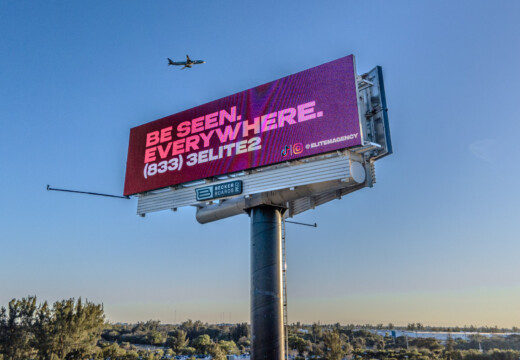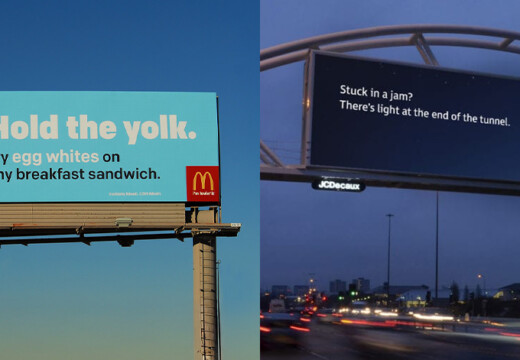Billboard placement near intersections is tightly regulated to ensure safety and minimize distractions. Here’s a quick breakdown of key rules:
- Federal Guidelines: The Highway Beautification Act requires billboards to be at least 500 feet from intersections on controlled routes. States risk losing federal highway funding if they fail to enforce these rules.
- State-Specific Rules: States often exceed federal requirements:
- Maryland: 100 feet from intersections within 1,000 feet, 300 feet beyond that.
- Montana: 150 feet within 1,000 feet of intersections, 300 feet farther out.
- Massachusetts: 500 feet for static billboards, 1,000 feet for digital displays.
- Missouri: 1,400 feet between billboards on highways.
- Mississippi: 500 feet for static, 1,000 feet for digital displays.
- Digital Billboards: Stricter rules apply due to potential distractions:
- Minimum spacing: 1,000 feet in many states.
- Brightness must not exceed ambient light by more than 0.3 foot-candles.
- Ads must remain static for 4–10 seconds with no animations or flashing.
- Local Regulations: Municipalities often impose additional restrictions, especially in scenic or historic areas, requiring permits and compliance with local ordinances.
Quick Comparison Table
| State | Static Billboard Spacing | Digital Billboard Spacing | Notes |
|---|---|---|---|
| Maryland | 100 ft (within 1,000 ft); 300 ft beyond | Same as static | Varies by proximity to intersections |
| Massachusetts | 500 ft | 1,000 ft | Stricter urban regulations |
| Missouri | 1,400 ft | Same as static | Uniform highway rules |
| Mississippi | 500 ft | 1,000 ft | Stricter for digital displays |
Understanding these rules is essential for advertisers to avoid fines and ensure compliance. Local permits, spacing, and design standards vary, so always check state and local requirements before placing a billboard.
Driving in New Zealand – An American’s Perspective
Federal Billboard Laws
The Highway Beautification Act (HBA) of 1965 is the cornerstone of billboard regulation in the United States, particularly for advertising structures near intersections and along federal highways. This legislation introduced safety and aesthetic standards that continue to influence how outdoor advertising is placed today. These federal rules provide the foundation for the specific spacing and display requirements outlined below.
Highway Beautification Act Requirements
The HBA emphasizes spacing to ensure driver safety and clear sightlines. For example, billboards must be placed at least 500 feet away from intersections or interchanges on controlled routes. This spacing helps maintain visibility for traffic signals and ensures merging traffic has unobstructed sightlines.
While the HBA establishes baseline rules, states adapt these guidelines to address local conditions. The Act identifies two main types of billboards:
| Billboard Type | Definition | Spacing and Permit Standards |
|---|---|---|
| On-premise | Advertises activities on the property | Fewer restrictions, often exempt from spacing rules |
| Off-premise | Promotes products or services elsewhere | Subject to stricter spacing and permitting requirements |
For billboards along interstate highways, the HBA imposes additional restrictions:
- A minimum of 500 feet between billboard structures
- Prohibition of flashing or intermittent lights that could distract drivers
- Clear visibility for traffic control devices
State Law Alignment with Federal Rules
To preserve federal highway funding, states must enforce regulations that meet or exceed HBA standards. Many states have adjusted these requirements to reflect local needs while maintaining compliance.
“States risk losing federal highway funding if they do not enforce HBA standards”, explains the Federal Highway Administration.
Some states have implemented stricter spacing rules than those required by the HBA:
- Kentucky: Requires 2,500 feet between electronic billboards on interstates
- Missouri: Mandates 1,400 feet between static billboards
- Massachusetts: Enforces 1,000-foot spacing for digital displays
States also manage their own permitting systems and enforcement processes. For example, Illinois requires specific permits for off-premise billboards and conducts regular inspections to ensure compliance with both state and federal laws.
State transportation departments typically handle enforcement, which includes:
- Issuing and revoking permits
- Conducting compliance inspections
- Removing non-compliant billboards
- Levying fines for violations
This federal-state partnership creates a framework that allows for local flexibility while adhering to national standards, setting the stage for the detailed local rules discussed in upcoming sections.
State Billboard Rules by Region
Western State Rules
Western states have their own set of rules for billboard placement, particularly near intersections, which often depend on the classification of the roadways. For instance, Montana enforces a 150-foot limit for billboards near intersections within 1,000 feet, but this extends to 300 feet beyond that range. Some states in this region, like California, go even further with stricter urban regulations for digital displays. These rules are designed to ensure clear sightlines and maintain scenic standards. Digital billboards must also meet federal guidelines to avoid distracting drivers, which include specific requirements for brightness, display duration, and transitions between ads.
Moving south, the Southern states take a slightly different approach to billboard safety and placement.
Southern State Rules
Southern states emphasize spacing requirements to enhance road safety. In Mississippi, static billboards must maintain a 500-foot distance from intersections, while digital and Trivision billboards require a 1,000-foot setback. Here’s a quick breakdown of the rules:
| Billboard Type | Minimum Distance from Intersections |
|---|---|
| Static Displays | 500 feet |
| Digital/Trivision | 1,000 feet |
| Urban Areas | Varies by city |
States like Texas and Florida follow similar guidelines, but local ordinances can add extra layers of regulation. For example, Houston enforces stricter setbacks, and Miami has stringent lighting controls to reduce visual distractions.
The Northeastern states, with their densely populated urban areas, approach billboard regulations quite differently.
Northeast State Rules
Northeastern states are known for their tough billboard regulations, especially in urban environments. Massachusetts, for example, mandates a 500-foot setback for static billboards and a 1,000-foot separation for digital displays. States like New Jersey and New York adapt their rules to address the complexities of metropolitan areas, focusing on maintaining visibility and controlling advertising density.
In 2020, Massachusetts introduced enhanced spacing requirements under Law 700 CRM 3.00. According to the Massachusetts Department of Transportation, these measures have helped reduce intersection-related incidents. Additionally, in cities with populations exceeding 50,000, federal spacing guidelines may be adjusted to better fit urban layouts. State transportation departments also have the authority to designate certain highways as “through ways” and implement traffic control measures at intersections.
Digital Billboard Requirements
Digital billboards near intersections face stricter rules than traditional static signs due to their potential to distract drivers. These regulations focus heavily on spacing and brightness, which directly influence the content guidelines outlined in state laws for digital displays.
Distance and Light Rules
Most states enforce larger spacing requirements for digital billboards compared to static ones. For instance, both Massachusetts and Mississippi mandate a 1,000-foot setback for digital displays, while static billboards only need to be 500 feet apart.
Here’s a quick look at some key state regulations:
| State | Minimum Distance Requirement | Additional Details |
|---|---|---|
| Montana | 500 ft from an interchange or intersection | 150 ft spacing if highways are less than 1,000 ft apart; 300 ft spacing if greater |
| Missouri | 1,400 ft between billboards | Applies uniformly to all highway signs |
| Mississippi | 1,000 ft for digital displays | 500 ft for static signs |
Brightness is another critical factor. To reduce glare and improve safety, digital billboards cannot exceed the surrounding ambient light by more than 0.3 foot-candles. Additionally, many states require nighttime brightness levels to be reduced by 50–65% near intersections.
State Digital Display Laws
Beyond spacing and brightness, state laws impose strict controls on ad content and display transitions. Ads must remain static for 4–10 seconds, and transitions must happen instantly – no special effects, animations, flashing, or video elements are allowed.
Montana’s regulations highlight some of the most stringent guidelines, explicitly banning:
- Flashing or intermittent lights
- Moving displays that could interfere with traffic signals
- Any content resembling or potentially confusing drivers with traffic control devices
Advertisers are responsible for ensuring compliance by:
- Securing the necessary local permits and paying associated fees
- Installing automatic dimming systems to adjust brightness levels
- Adhering to state timing standards for display transitions
- Keeping billboards properly spaced from traffic signals
- Reviewing all content to meet state-specific requirements
These rules aim to balance the benefits of digital advertising with road safety, ensuring that drivers remain focused while passing through busy intersections.
sbb-itb-2e2e93f
Local Rules and Permits
In addition to federal and state regulations, local ordinances play a significant role in determining where billboards can be placed, especially near intersections. These municipal rules often impose stricter requirements, prioritizing traffic safety and maintaining the visual appeal of the community. They also set the framework for a detailed permitting process, which can vary depending on the jurisdiction.
Getting Local Permits
When applying for a local permit, you’ll typically need to provide:
- Site plans that show the proposed location and distances from intersections
- Structural engineering plans
- Property owner approval
- Traffic safety studies
- Light impact assessments (for digital billboards)
Permit fees usually range between $200 and $1,000, depending on the location and type of billboard. The approval timeline can vary, often taking anywhere from 30 to 90 days. Digital billboard applications, however, may require additional review due to their complexity.
| Permit Type | Typical Processing Time | Required Documentation |
|---|---|---|
| Static Billboard | 30–45 days | Basic site plan, engineering drawings |
| Digital Billboard | 60–90 days | Site plan, light study, message timing plan |
| Historic District | 90+ days | Design review, preservation impact study |
These local permitting processes highlight how municipal standards refine and expand upon broader state and federal guidelines.
Special Area Rules
In historic districts, billboard designs must align with the area’s character, which often means using traditional materials, reducing billboard sizes, avoiding digital displays, and adhering to strict lighting standards.
Scenic corridors come with even stricter regulations. For example, the required spacing between billboards and intersections can double. If the usual setback is 500 feet, scenic corridors may extend it to 1,000 feet or more. Additionally, height limits in these areas are often capped at 20 feet.
Municipalities also allow for variances in specific cases. These exceptions might include:
- Adjusting dimensions to accommodate property constraints
- Modifying height for elevated placement
- Allowing exceptions for buildings that block cross-vision
Each variance request must demonstrate that it won’t compromise traffic safety or negatively impact nearby properties. This is especially important near busy intersections or in areas where maintaining aesthetic standards is a priority. These detailed local rules ensure billboards remain safe and visually appropriate while adhering to broader regulatory frameworks.
Meeting Billboard Requirements
Finding Legal Billboard Spots
Once you’ve familiarized yourself with state-specific spacing rules, the next step is to locate legal billboard spots. Blip‘s interactive marketplace simplifies this process by offering detailed location data and compliance metrics. This tool helps advertisers navigate the varying requirements across states. For instance, states like Maryland and Michigan enforce specific spacing rules that must be factored in when choosing billboard locations.
Blip also provides real-time traffic data and impression metrics, so you can assess the potential effectiveness of each location.
“Working with Blip has given Mr. Charlie’s the momentum to get our new location on the map while accelerating growth for our original location.”
Here’s a quick look at spacing requirements in a few states:
| State | Highway Spacing | Off-Highway Spacing |
|---|---|---|
| Massachusetts | 500 feet | 500 feet |
| Mississippi | 500 feet | 500 feet |
| Missouri | 1,400 feet | Varies by zone |
Once you’ve secured a compliant location, the next hurdle is designing an ad that meets both legal and advertising standards.
Creating Rule-Compliant Ads
After identifying a legal spot, the focus shifts to creating an ad that not only complies with regulations but also captures attention. Blip’s two-step moderation process ensures your ad meets these standards. First, they review it for compliance – typically within 90 minutes – and then secure owner approval within 1–3 days. This streamlined process ensures your ad adheres to regulations while maximizing its impact.
“Billboards are one of the most impactful ways to advertise, and with Blip, you spend a fraction of what you would end up paying elsewhere.”
For digital billboards, which often come with stricter rules, here are a few best practices to follow:
- Keep brightness levels within legal limits.
- Avoid fast or abrupt content transitions.
- Use high-contrast designs to enhance visibility.
- Limit text to 7–10 words for better readability.
- Follow state-specific digital display rules, such as Massachusetts’s 1,000-foot spacing requirement.
Summary
Understanding billboard regulations involves navigating both federal guidelines and state-specific rules. At the federal level, the Highway Beautification Act sets the groundwork, but states often impose stricter standards, particularly near intersections and highway interchanges.
For example, states apply unique spacing rules to align with local needs. Here’s a breakdown of a few state-specific requirements: Maryland requires a minimum spacing of 100 feet within 1,000 feet of an intersection and 300 feet beyond that. Massachusetts mandates 500 feet for static billboards and 1,000 feet for digital ones. Meanwhile, Missouri enforces a minimum of 1,400 feet on highways, and Mississippi requires 500 feet for static billboards and 1,000 feet for digital displays.
To help advertisers stay compliant, Blip’s interactive marketplace offers tools to simplify the process. By providing location-specific metrics and regulatory information, the platform ensures advertisers can meet both state and local requirements. Blip’s moderation process includes an internal review completed within 90 minutes and final approval from the billboard owner within 1–3 days, ensuring ads align with all applicable standards before going live.
Here’s a quick comparison of spacing benchmarks in select states:
| State | Static Spacing | Digital Spacing |
|---|---|---|
| Maryland | 100 ft (within 1,000 ft of intersection); 300 ft otherwise | Same as static |
| Massachusetts | 500 ft | 1,000 ft |
| Missouri | 1,400 ft (on highways) | Same as static |
| Mississippi | 500 ft | 1,000 ft |
Additionally, some states take a stricter stance. For instance, Maine has banned billboards entirely. Always double-check both state and local regulations before launching a campaign, as requirements can differ significantly based on location, whether urban or rural, or depending on zoning classifications.
FAQs
How do local, state, and federal regulations affect billboard placement near intersections?
Billboard placement near intersections is subject to a combination of federal, state, and local regulations. At the federal level, the Highway Beautification Act provides overarching standards aimed at maintaining safety and reducing driver distractions. However, individual states and municipalities often introduce their own rules, which can include stricter requirements regarding billboard size, proximity to intersections, or driver visibility.
Because local regulations can differ widely, it’s crucial to review the specific rules in your area before moving forward with any billboard plans. These guidelines aim to strike a balance between allowing advertising and ensuring traffic safety while maintaining the visual appeal of the community.
What challenges do advertisers face when following digital billboard regulations?
Advertisers face a maze of challenges when dealing with digital billboard regulations, as the rules can differ widely depending on the state or local jurisdiction. Common restrictions include limits on where billboards can be placed, such as near intersections or highway interchanges, as well as rules governing brightness levels, animation effects, and zoning laws that dictate permissible installation areas.
Successfully managing these regulations calls for thorough planning and a solid understanding of local laws. It’s crucial to stay up to date with state-specific guidelines to ensure billboard campaigns not only comply with the law but also achieve maximum visibility and effectiveness.
What is the Highway Beautification Act, and how does it impact state billboard regulations?
The Highway Beautification Act (HBA)
The Highway Beautification Act (HBA) is a federal law aimed at managing outdoor advertising along highways to maintain scenic views and promote safety. It establishes rules for billboard placement, size, lighting, and spacing near interstates and other major roads. However, while these federal standards provide a framework, individual states have the authority to implement their own specific regulations within these guidelines.
Failing to comply with these rules can lead to serious consequences, such as fines or even the removal of billboards. To steer clear of such problems, advertisers should carefully review the specific requirements of the state where their campaign will run and ensure every aspect aligns with the law. Staying informed is key to avoiding costly mistakes.


